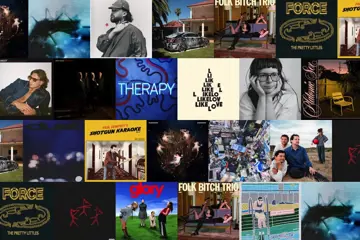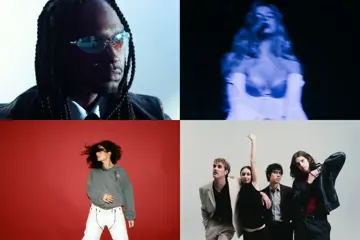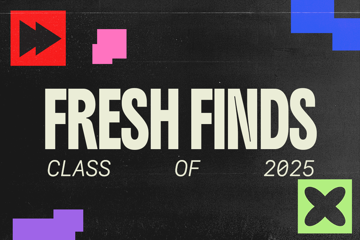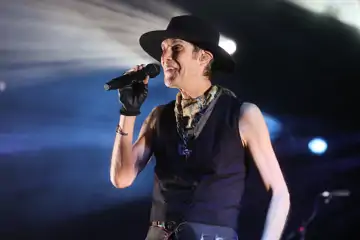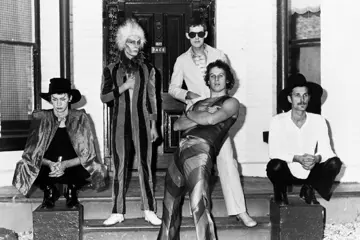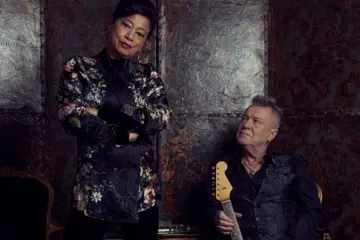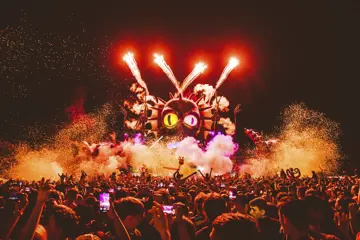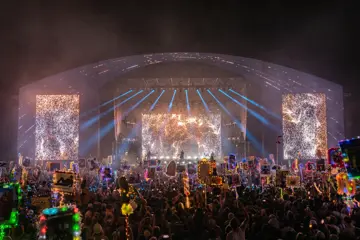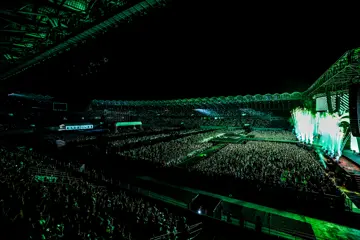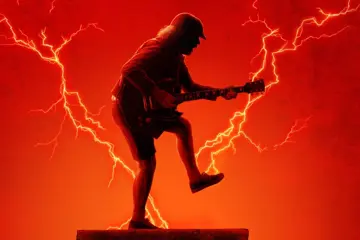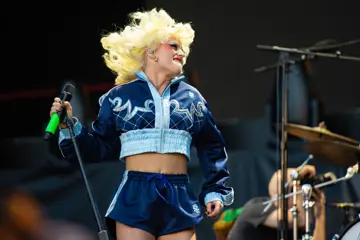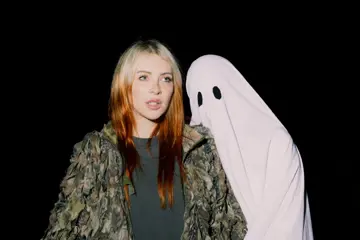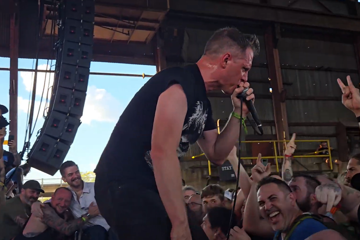Strike up a conversation with an artist and it won’t be long before they start talking in metaphors. When it comes to art’s emotional and psychological subtleties, metaphor becomes the equivalent of translation, carrying across meaning from one mindset, one culture, one realm of understanding to another. The semantics an artist chooses to unriddle their thinking can also be revealing. As we discuss the philosophy behind his 2019 program, Sydney Festival Director Wesley Enoch speaks of foundations, of windows, of using tools. Perhaps it’s little wonder that the architect of the city’s flagship arts event should adopt the language of a builder.
Entering his second year at the helm of Sydney Festival, Enoch says he hopes the program constructs “safe spaces”, although that’s not to say 2019’s fest will steer clear of difficult subjects or political conflict, he insists. “It’s not an apologist position. We’re not saying, ‘Oh yeah, I know things are really bad, but here’s something so you can forget about it.’ It’s got a few more teeth than that I think. We’re saying, ‘Here are the tools to deal with these situations.’ It’s not enough to just accept the world as it is. We have to keep questioning it so we can build a better one.”
"It’s not enough to just accept the world as it is. We have to keep questioning it so we can build a better one."
American theatre-maker Geoff Sobelle is also a builder, but of a less abstract variety. In Home, one of the major international imports on Sydney Festival’s 2019 bill, Sobelle quite literally builds a house on stage. Through a complex choreography of cutting-edge stagecraft and precisely positioned actors, the show charts the “life-cycle of a structure”.
“One of the biggest inspirations was the theatre itself. As an actor, I feel at most at home in a theatre and I was thinking about how wild it is that we occupy the theatre for just a short amount of time, and yet it becomes this shared space,” Sobelle explains. “I made this piece for a very specific theatre in New York. And so I approached the process of making it being very clear of the how and why and what of what I’d want to do. It was also a theatre in Brooklyn, which I don’t know if you know, is a place that’s gone through a lot of gentrification in recent years. So that immediately got me thinking about housing and the concept of home – whose home is this? Who belongs here?”
Since opening in New York last year, Home has already toured to several countries beyond the US, including Australia where it had its Down Under debut at the 2018 Brisbane Festival. While its original iteration may have been site-specific, the show’s exploration of belonging and shelter has easily resonated with respective international audiences. Partly, this is thanks to Home’s flexible ambiguities. The show is largely wordless, but far from making its content aloof, the absence of any explicit cultural references or dialogue makes space for local passions, bringing a potent emotional power to the fore.
“You‘re seeing all of the different lives that maybe lived in that structure, past and present – or maybe they’re future possibilities. It’s hard to say and it’s supposed to be ambiguous. What I thought was interesting, we’re always sharing space. Even if you’re in a brand new building, the land that you’re on – someone lived there before you. And someone will most likely live there after you. Wherever we are, where we work, where we visit, where we live, we exist with the marks of the people who came before and we leave marks for the people who will come after,” Sobelle says. “We're a very myopic animal, human beings. We think in narrow terms. We understand what home means to us in the immediate, but we can’t really hold in our head that a generation ago, someone else was sitting where you’re sitting, that they were your exact age and thought of that place in similar terms but with a completely different mindset: it was their home, the place where they felt they most belonged. In that strange way, we are always sharing spaces with these ghosts.”
Enoch has also been contemplating the meaning of home. As with his inaugural season last year, his mandate in 2019 has not merely been to bring exciting international works to Aussie audiences, but to ensure the diversity of our homegrown stories are also proudly represented. This balance between imported and local work is vital to the festival’s mission, Enoch says.
“There’s always a relationship between bringing in international work that challenges us in terms of content, in terms of form, aesthetics, different ways of working. But that’s useless unless we see how it informs local artists and local practice. To see them side by side in equal measure is very important. Also, there are certain cultural and artistic ambitions that local artists have for our country that are very direct. Whereas in international work, those cultural ambitions for our country are so indirect all we can do is look at it objectively, from the outside looking in. With Australian work, we are innately in the middle of it, as an audience member, as a community. I’ve always liked the idea of balancing programming in that way because festivals are about prototyping change. To witness that change manifest in an artist’s vision for their culture and their identity, whether that’s national or personal, is really important.”
One such call for change is at the heart of Man With The Iron Neck, by physical theatre company Legs On The Wall. After experiencing first-hand the suicide of a close relative, aerialist Josh Bond was compelled to confront that grief through his art. But as a First Nations Australian, this drive also came with an added sense of urgency; it's estimated that suicide rates within Indigenous communities are six times higher than the national average. "I remember thinking. 'Fuck. It's gotta fucking stop. This has just gotta fucking stop,'" Bond says. "Feeling the need to address this issue in some way, well I'm a theatre-maker, so using that soapbox to create something that actually can be a part of the healing and bring some change by encouraging people to talk about it felt really important. Because this subject is so shrouded in taboo."
Collaborating with acclaimed writer-actor Ursula Yovich, who wrote the script for the production, Bond has drawn on his own experience of suicide and counterpointed it with the story of The Great Peters — an early 20th-century circus star who wowed crowds with an astonishing trick: he could throw himself from a bridge, a rope tied around his neck, and survive. The result is a production that pairs the physical daring of aerialism with a deeply moving narrative. "Making this show really threw up a lot of questions for me about our mortality and the risks we take. And also the context of those risks; whether that risk is intentional and what is the intended outcome is," Bond explains.
"Encouraging people to talk about it felt really important."
Yovich’s role as playwright would present her with a unique challenge, managing duel responsibilities as both dramatist and stenographer of real, lived experiences. While she had not been directly impacted by the suicide of a loved one, her cultural connection to the crisis made the experience of creating Man With The Iron Neck a profoundly affecting one. “I think any First Nations people you come across, we’ve all experienced it to some degree. For me it’s been a real personal journey,” she shares. “The piece itself isn’t explicitly based on anyone in particular; it is a completely fictional imagining that’s based loosely on truth. But the stuff that I’ve put in there, the reasons why I think suicides are so high within my community, that’s based entirely on fact and reality. It’s difficult to separate yourself from that. Even though this story is so remote from my personal experience growing up, it definitely draws from my experience now, as a black person living in this country.”
Premiered at the Brisbane Festival last year, its second season in Sydney will bring an important story to the stage that has nationwide relevance. But it will also be an important moment for Bond personally. "I'm 36 now, and I was like 20 when I first began thinking about this show, so it was probably one of the very first show ideas I ever had. And I quite clearly remember thinking at the time, 'I'm a young fella, and as I get older and more experienced and whatnot, I'll have other ideas.' But it's funny how that yarn has stayed with me for so many years, and how it's coming full circle now."
A pair of new pieces by Townsville-based company Dancenorth explore a different Australian story. Through the medium of contemporary choreography and live music, Dust and One Infinity reveal how movement can investigate concepts that far exceed traditional storytelling, examining two very different yet inherently linked perspectives on multiculturalism, migration, dispossession and what it means to belong.
Created by Artistic Director Kyle Page and Associate Artistic Director Amber Haines, Dust has a pointed political message at its core. "It's about the idea of inheritance and the fact that we're born into a world that's been designed and predetermined by those who have come before us," Page says. "We have very little capacity or agency to alter or shift those systems and those structures that we are born into and have to abide by. But I guess what we're trying to do is hopefully create a sense of potentiality in this idea, that maybe we can reassess, or we can reframe our relationship to some of those systems. Can we collectively move towards perhaps evolving, shifting, or transcending some of them?"
"We're born into a world that's been designed and predetermined by those who have come before us."
Given the complexities and anxieties that are in orbit around the current geopolitical status quo, Page hopes Dust will connect to these broader social concerns, leaving his audience with plenty to contemplate. "I think what we're really curious about is just inviting the audience along for the ride, hoping that they will go away with a sense of empowerment, or even just a curiosity that perhaps we can reimagine the world and look at the way that we relate to the world and relate to one another," Page shares. "I'm hoping the audience will be inspired to question some of the social, cultural, political and personal systems and structures that are in place, and whether they serve us now as perhaps they did in the '50s. Perhaps they did serve our grandparents, but do they now? We're simply asking the question regardless of the answer; it's where that leads the audience that we're really curious about."
The antithesis of the same multicultural debate can be found in Gideon Obarzanek’s One Infinity, a collaboration with Australian recorder virtuoso Genevieve Lacey, Chinese musician Wang Peng and Beijing Dance Theatre. This beautifully immersive production is built on the bedrock of clear cultural dialogue that at once celebrates our distinctive differences while embracing the shared humanity that binds us together. The audience members are folded into the make-up of the performance, tasked with repeating simple gestures from their seats. The effect is powerfully galvanising and surprisingly spiritual.
“It’s an antidote in some ways to the fragmentation of community and doing things together in a secular society,” Obarzanek says of the audience’s participation. “It certainly fulfills a role that probably would have been done in a more religious context in the past, whether that involved singing or dancing or reading. I think in some ways, theatre is always evolving and responding to its environment. Technology has become so advanced, and that’s wonderful, but it’s also isolated us in a way. I think theatre-makers have to ask the question: why does this performance need to happen? Why do we need to be here together as a group to do this? Because arguably there’re many other ways of achieving the same result. For me, the live space is about privileging the live-ness of things, that’s the space that I’m interested in. It’s not just about performers being present. It’s about the experience of the audience members being there.”
The subtext of the work is perhaps less insistent than Dust's, but Obarzanek believes this gentle tonality, paired with the democracy of the audience's involvement, is an important political comment, nonetheless. “There’s a sense of wonderment or a search for meaning or understanding that occurs when we’re part of something larger than our individual selves. Much of the piece was made in Beijing, and it’s an intense city very much like Chicago or Delhi or New York. When you come into a room and you close the door, there’s almost this sigh of relief that you can finally let down your guard and relax. You brace yourself when you have to go back outside. When we were in Beijing with one of the audience test groups, there was a moment, a contrasting moment away from the large city and that intense energy, where we were able to divest ourselves of all those things simply by listening and doing. So, I think One Infinity is particularly relevant in very busy, urban places, because it’s kind of a refuge from that world.
“I think there’s something that comes through in the work that draws on Chinese culture, about balance and harmony and meditation. That is particularly useful. We can all learn from that I think, especially right now, at this point in time.”
Sydney Festival runs from 9 Jan.

